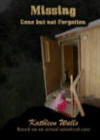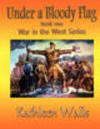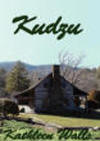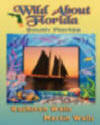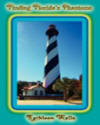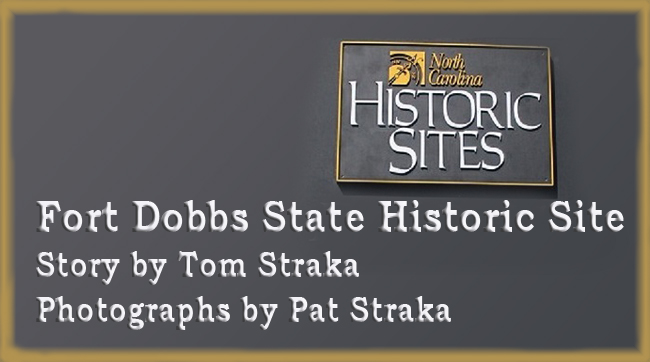
During the COVID-19 pandemic we have visited attractions that
were primarily out-of-doors and generally not that far off the
highway. Fort Dobbs State Historic Site meets those
requirements, being nearly at the intersection of Interstates
40 and 77, just north of Statesville, North
Carolina. Most forts in the South were associated with the
Revolutionary or Civil Wars. Fort Dobbs is a French and Indian
War fort! It is the only state historic site associated with
that period in North Carolina. The site is similar to
Oconee Station
in South Carolina, visited last October and described in an
ARGH article, in that it is mainly a blockhouse and it is
situated on what was back then the frontier, the foothills of
the Blue Ridge Mountains.
 |
| State historical marker notes the fort’s place in the French and Indian War. |
 |
|
The main structure at the fort is a massive blockhouse. |
By 1750 settlers had begun to populate the western frontier of
North Carolina, mainly driven by immigration along the Great
Wagon Road, and in 1756 Governor Arthur Dobbs decided a
fortification was necessary to protect these new settlers from
French instigated Native American attacks. Governor Dobbs
stated the fort would be a place of “retreat” for the “back
settlers,” as this area was “beyond the well settled area”
with no other place on the frontier that would offer any
protection. Without a fortification, the “Indians might pass
them and murder the inhabitants, and retire before they durst
go to give them notice.”
The historic site includes examples of everyday technology
that would have been used around the fort. The is a cob bread
oven that would have been used to prepare food. Cob
(commingled clay, sand, and straw) was a common building
material for ovens, as it serves a large mass that absorbs and
retains heat. The oven had no chimney; a fire was allowed to
burn inside with the smoke billowing out the door. Once the
oven was heated, the ash and coals were raked out and the
retained heat would cook the bread or other food. A small
blacksmith shop sits next to the cob oven.
 |
|
The cob bread oven. |
 |
|
A small blacksmith’s shop with primitive tools. |
The History
The background is the French and Indian War.
The British and French were enemies over the first half of the
eighteenth century, culminating in the Seven Years War
(1756-1763). A subset of that conflict in the New World
involved New France and the British colonies over control of
the land on the west side of the Appalachian Mountains. It
involved the frontier settlers, the military, and the Native
Americans allies of each side. In early 1754 France desired to
expand its control of North America, by unifying its Canadian
lands with Louisiana. This would be accomplished via a series
of military posts stretching from the Great Lakes down the
Ohio River Valley. The same lands were claimed by the British
as within the Province of Virginia. Virginia called for
assistance to respond to the intrusion and North Carolina was
the first state to offer military assistance by sending troops
to participate in the Ohio expedition. As the war raged on,
tensions developed between the French-allied Cherokee and the
British, and, after dozens of Cherokee warriors were killed by
the Virginia provincials, hostilities grew to open warfare.
North Carolina needed to protect its frontier.
Fort Dobbs was that protection and was the
sole permanent frontier provincial fortification in the colony
of North Carolina. Construction occurred over 1755-1756. The
fort served as the military headquarters for a company of
frontier soldiers (roughly 50 men) and as a refuge for
settlers in danger of attack. The protection would come from a
large blockhouse, described as:
"A good and
Substantial Building of the Dimentions following (that is to
say) The Oblong Square fifty three feet by forty, the opposite
Angles Twenty four feet and Twenty-two, In height Twenty four
and a half feet as by the Plan annexed Appears, The Thickness
of the Walls which are made of Oak Logs regularly Diminished
from sixteen Inches to Six, it contains three floors and there
may be discharged from each floor at one and the same time
about one hundred Muskets the same is beautifully scituated in
the fork of Fourth Creek a Branch of the Yadkin River."
 |
| Daniel Boone is associated with the fort. Some of his family took shelter in the fort and he may have served as a North Carolina frontier provincial soldier. |
 |
| The view from one of the
loopholes. A loophole is a protected small opening in
a blockhouse that allows for defense by protecting a rifleman while he is firing upon the enemy. Fort Dobbs had three floors and each floor had 100 loopholes. |
There was a Cherokee attack on the fort on
the night of February 27, 1760 by more than 60 Native
Americans. The attackers were repelled. The British suffered
one casualty (a colonial boy) and two men wounded. About a
dozen Cherokee were wounded or killed. Colonel Hugh Waddell,
commander of the North Carolina provincials described the
attack to Governor Dobbs as:
“We had not
marched 300 yds from the fort when we were attacked by at
least 60 or 70 Indians ... We recd the Indian's fire: When I
perceived they had almost all fired, I ordered my party to
fire which We did not further than 12 Steps each loaded with a
Bullet and 7 Buck shot, they had nothing to cover them as they
were advancing either to tomahawk or make us prisoners ... the
Indians were soon repulsed with I am sure a considerable Loss,
from what I myself saw as well as those I can confide in they
cou'd not have less that 10 or 12 killed and wounded ... On my
sided I had 2 Men wounded one of whom I am afraid will die as
he is scalped, the other is in a way of Recovery, and one boy
killed near the fort."
The British had substantially won the war by
the end of 1761. Only 30 soldiers needed to remain at the
fort. Gradually the frontier moved west of the fort and the
Colonial leaders demobilized the troops and abandoned the
fort. By 1766 the
fort was reported to be in ruins.
Tours inside the blockhouse are given
throughout the day by an interpretative historian. Having such
a qualified tour guide made for a fantastic overview of the
fort. Below are four views of the blockhouse inside, including
the enlisted bunks and officer’s quarters.
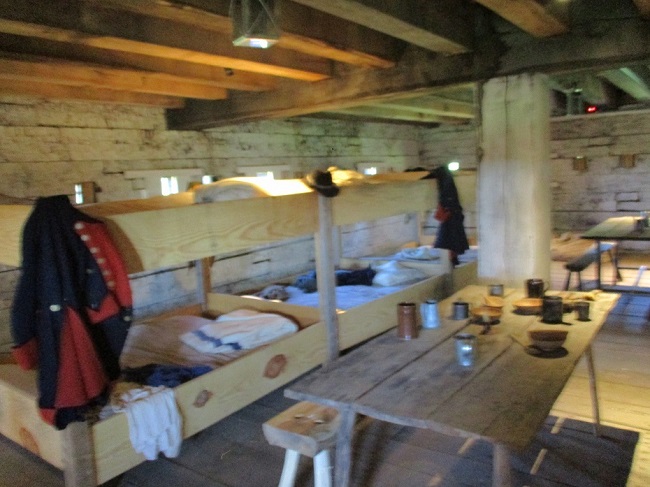
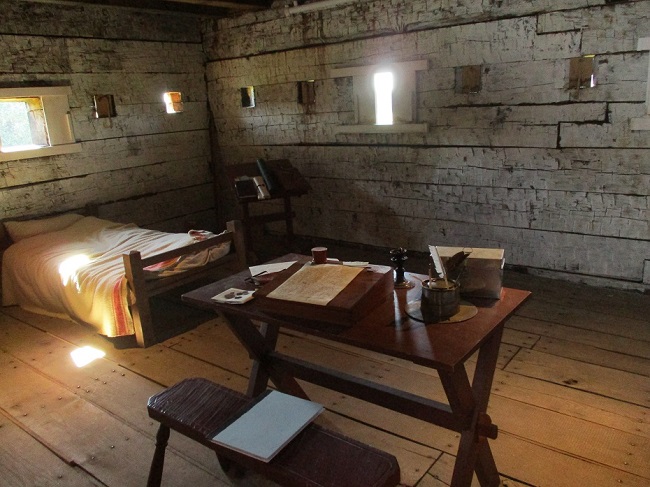


The site includes a visitors center with
displays and items that would have been in the fort (see
below). The center includes displays with historical
background. There are restrooms and a picnic area.
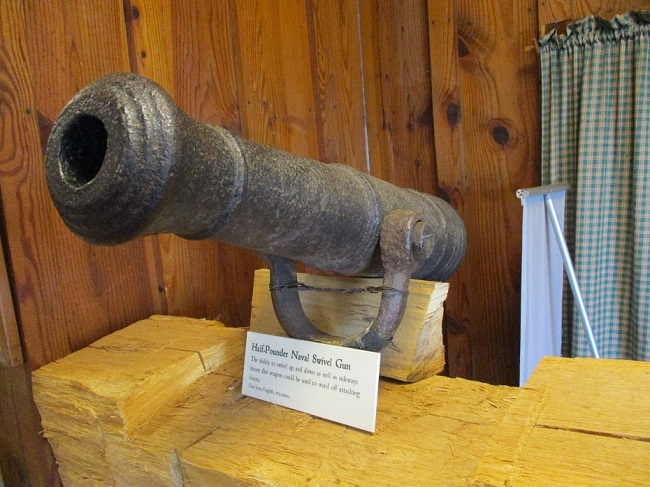

There are few historic sites related to the
French and Indian War. That makes this site particularly
interesting and unusual. It is the perfect place to slip off
the interstate and learn some American history.
Author/Photographer. Tom Straka is an emeritus professor of forestry at Clemson University. He has an interest in history, forestry and natural resources, natural history, and the American West. Pat Straka is a consulting forester and the photographer on most of their travel articles. They reside in South Carolina and have also lived in Mississippi and Virginia.
As an Amazon Associate, I earn from qualifying purchases.
The FTC has a law requiring web sites to
let their readers know if any of the stories are
"sponsored" or compensated. We also are to let readers know if any of
our links are ads. Most are not. They are just a way to
direct you to more information about the article
where the link is placed. We have several ads on
our pages. They are clearly marked as ads. I think readers are smart
enough to know an ad when they see one but to obey the
letter of the law, I am putting this statement here to
make sure everyone understands. American Roads and
Global Highways may contain affiliate links or ads. Further, as
their bios show, most of the feature writers are
professional travel writers. As such we are frequently
invited on press trips, also called fam trips. On these
trips most of our lodging, dining, admissions fees and
often plane fare are covered by the city or firm hosting
the trip. It is an opportunity to visit places we might
not otherwise be able to visit. However, no one tells us
what to write about those places. All opinions are 100%
those of the author of that feature column.
We'd love your comments!






















